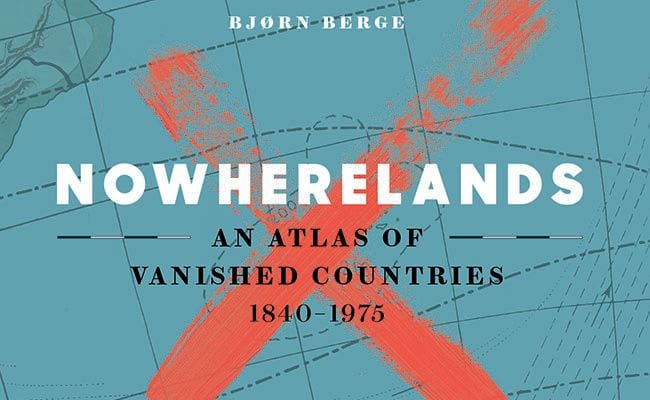
The unmistakable impression (undoubtedly intentional) that Nowherelands leaves the reader is that of a scrapbook, piecing together the remnants of its “vanished countries”. In stamps and historical scraps of information, Bjorn Berge leads readers on a charming survey of fallen nations and eclipsed colonies. Documenting the often but not always brief histories of since vanished nations between 1840 and 1975, Nowherelands rests most distinctively on the author’s stamp collection. As Berge explains, the ability to issues its own stamps serves as a reasonable standard by which to measure a nation’s authority in the modern era. As interesting as the stamp included for each nation, however, are the lists of books, films, music, or art appended to each entry, providing entrée to further insight beyond Berge’s necessarily brief profiles.
In a time of resurgent nationalism and secessionary referenda like that in Catalonia, the profiles in Nowherelands serve as reminders of the humbling power of history. As Berge writes, “But irrespective of the reason for establishing a new country, the … fall always lies in wait — as inevitable as it is inexorable.”
Berge describes the stamps with the unmistakeable savor of an avid philatelist. He provides detailed descriptions of the miniature artworks, ranging from the details of the illustrations to the care put into individually perforating the stamps by hand, to the flavors faintly detectable upon certain stamps’ backs. They are, after all, the framework upon which Berge has built this book. Some of the most genuinely impressive (especially considering their dates of origin) include that of Hejaz, an intricate “motif from stucco work” drawn in Arabic calligraphy; Labuan, with its crocodile that does indeed seem suited for the cover of an adventure novel; Tannu Tuva, a diamond-shaped stamp imprinted with a provincial camel driver and based on an earlier photograph; Ryukyu, a beautifully drawn apsara, playing her flute; and Upper Yafa, in an elegant homage to Edgar Degas.
Often Berge’s profiles combine philatelic study with actual history and descriptions of relevant literature. For the Far Eastern Republic, it is Doctor Zhivago that serves as the gloss upon a Bolshevik “buffer state” destined to last only two years (1920-1922). In this case, Berge reminds the reader that while the author, Boris Pasternak, did win the Nobel Prize for Literature in 1958, the award is often regarded as the victim of an American pressure campaign, its bestowers hoping to use the win for propaganda purposes.

1934: Special issue in connection with the Oasis Circuit air race and a trade fair in Tripoli (courtesy of Thames & Hudson)
The Far Eastern Republic wasn’t the only proxy in the war between two world powers. For the tiny island of Labuan, it is the adventurous novels of the “Italian Jules Verne” Emilio Salgari that gives readers a window into the prototypical archetype of the South Asian setting — one of “stormy seas and awe-inspiring jungles, where … we are taken along on an improbable tiger hunt in the interior of Labuan”. As much as the stamps, it’s the cultural artifacts of these lost states that demonstrate their legacy, from literature to art to music. Many times, a state described is a necessary bridge in the transition from one world power to another; but at other times, it’s the product of something more universal, like the right to self-governance. It’s in the latter instances that the nation’s ultimate “vanishing” stands out the most.
Nations like the Far Eastern Republic, Batum, and Eastern Karelia make their brevity easily digestible. (The latter didn’t even survive a year.) The history of the 19th and 20th centuries, including the emergence of the Soviet Union and its subsequent fracturing, is filled with ample subject matter for a book like this.
More interesting than these, however, are the nations included in Nowherelands that last decades, even more than a century. Bhopal, for instance, lasted from 1849 to 1919. Its name now perhaps more synonymous with the horrific disaster of 1984, Berge’s book reminds us of a fascinating history of female rule stretching from 1818 to 1926. It is one of these women rulers, Shah Jahan Begum, whose name circles the faded and aged stamp in Berge’s collection. Another Indian nation included is the princely state of Alwar, enduring from 1771 until it was incorporated into the Indian Union (like Bhopal eventually) in 1949. In another peculiar flourish, Alwar’s cultural profile includes a kalakand recipe (in addition to the book Winter India).

1931: Canal Zone issue showing the Gaillard Cut (courtesy of Thames & Hudson)
Since the turn of the 21st century, a handful of new states have emerged, including the newest nation-state, South Sudan, in 2011. From the breakup of the Soviet Union, others redefined themselves in the late 20th century, and as alluded to, Catalonia voted for independence from Spain just this year (the outcome is unresolved). Nowherelands is an engaging time capsule. As Berge explains in the Foreward, “You’d be much better off looking at this book as a collection of bedtime stories to feed your dreams and carry you off into sleep.” Nowherelands is precisely that: a gentle reminder that history rolls on and the land will outlast us all.

